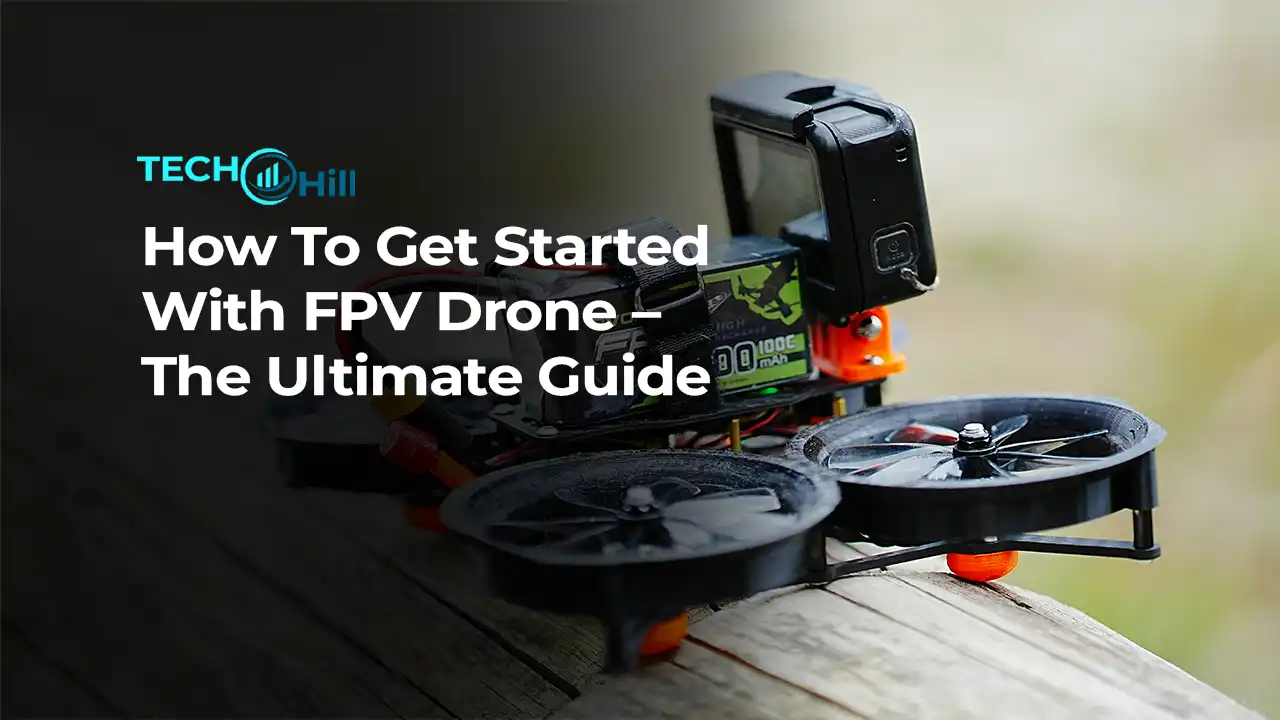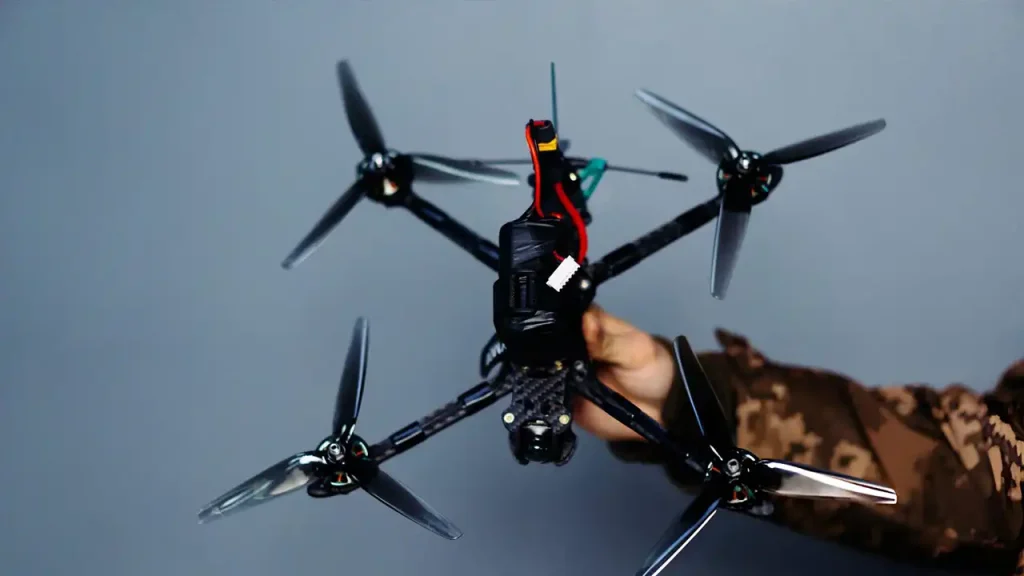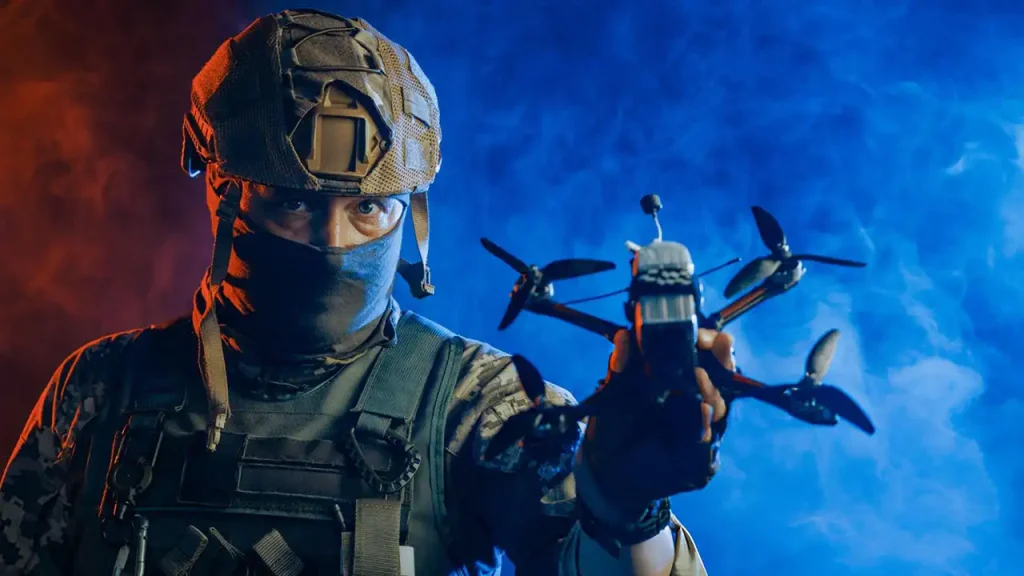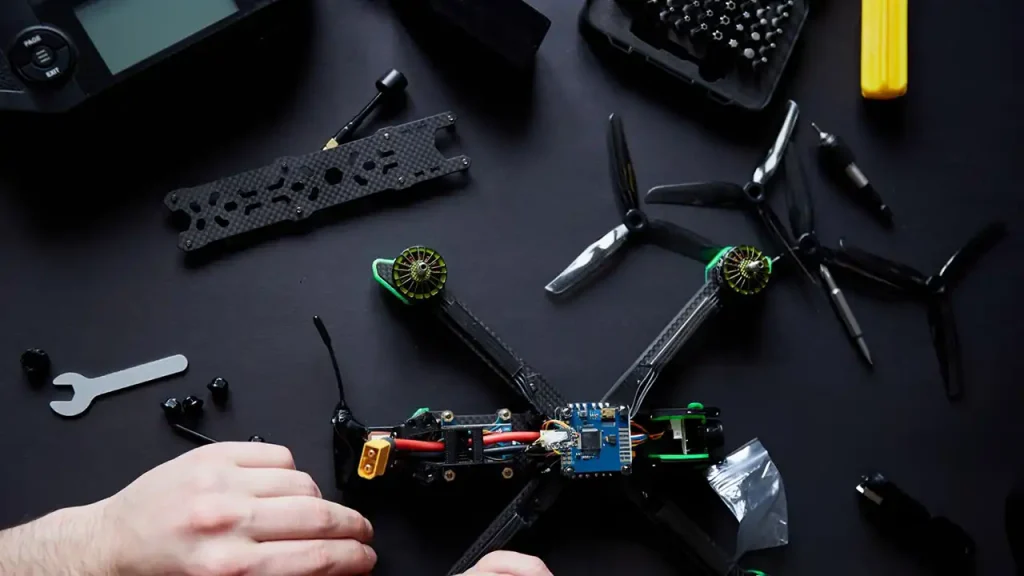How To Get Started With FPV Drone – The Ultimate Guide

Imagine soaring through the skies, dipping low over rushing rivers, and sweeping through narrow canyons—all from the comfort of the ground. This isn’t just the stuff of dreams or the exclusive thrill of pilots. With an FPV (First Person View) drone, you can embark on a breathtaking journey, experiencing flight as if you were in the cockpit.
These drones aren’t just about high altitudes; they’re your ticket to an immersive adventure in the skies, transforming the way we interact with the world above. Dive into the exciting realm of FPV drones and discover how they are changing the perspectives of enthusiasts and professionals alike.
How Do FPV Drones Work?
FPV drones are marvels of modern technology, providing an exhilarating, eye-in-the-sky experience that feels straight out of a sci-fi movie. At their core, these drones operate through a seamless integration of components and technology, designed to give the user a firsthand flying experience.
At the heart of an FPV drone setup is the camera, mounted directly on the drone, capturing live footage that mimics the view one would see if piloting the drone themselves. This footage is instantly transmitted via radio signals to goggles or a handheld monitor that the user wears or holds. These goggles or screens display the live video feed, enveloping the user in a 360-degree panorama of the drone’s aerial journey.

The drone is piloted using a handheld controller, which communicates with the drone via a robust radio frequency link. Pilots control the drone’s movements with sticks that adjust pitch, roll, yaw, and throttle, offering precise maneuverability that is essential for FPV flying. This setup allows for quick adjustments and reactions, essential for FPV racing or navigating through complex terrains.
What Are The benefits of flying an FPV drone?
Flying an FPV drone offers a unique blend of benefits that extend beyond the conventional drone experience, providing both practical advantages and thrilling recreational opportunities.
1. Immersive Experience: Unlike standard drones, FPV drones offer a first-person view, literally putting you in the pilot’s seat. This immersive experience is not just about the thrill; it enhances spatial awareness, making it easier to navigate through complex environments and execute precise maneuvers.
2. Enhanced Control and Precision: With real-time video feedback, pilots can make immediate adjustments, allowing for incredibly precise flying. This is especially useful in FPV racing, where precision and speed are crucial, or in scenarios requiring careful navigation around obstacles.
3. Educational Value: Learning to fly an FPV drone can be highly educational. Pilots must understand basic aerodynamics, electronics, and radio technology, not to mention the skills involved in effective piloting, including quick reflexes and decision-making.
4. Accessibility to Inaccessible Areas: FPV drones can go where traditional cameras or manned vehicles cannot. This capability is invaluable for industries like agriculture, where drones are used to survey vast lands, or in filmmaking, where they capture stunning aerial shots in hard-to-reach places.
5. Racing and Community Events: FPV drone racing has become a popular sport worldwide, featuring high-speed competition with other pilots. This sport fosters a community of enthusiasts who share a passion for technology and competition, creating friendships and networks.
6. Therapeutic Effects: For some, piloting an FPV drone can be incredibly therapeutic, offering a form of “digital” escape that focuses the mind and provides relief from daily stresses. The concentration required to pilot helps maintain present-moment awareness, akin to mindfulness practices.
7. Advancements in Technology: Regular use and increased interest in FPV drones drive technological advancements that improve performance, safety, and user-friendliness, benefiting the broader drone industry.
What equipment do you need to become an FPV drone pilot?
Embarking on the journey to become an FPV drone pilot is exciting, and having the right equipment is essential to ensure both a successful and enjoyable experience. Here’s a breakdown of the essential gear you’ll need:

1. The Drone: Naturally, the drone itself is the cornerstone of your equipment. For beginners, choosing a ready-to-fly (RTF) FPV drone might be the best option, as it comes pre-assembled with all necessary components. More experienced pilots might opt for build-your-own kits, which allow for customization and upgrades.
2. FPV Goggles: These are perhaps the most distinctive part of an FPV pilot’s gear. FPV goggles range from basic models with limited features to advanced setups with high-resolution displays, head tracking, and more. The goggles provide the immersive view that defines FPV flying, letting pilots see exactly what the drone sees in real time.
3. Controller/Transmitter: A reliable controller is crucial for precise maneuvering. Most FPV drones use a 2.4 GHz radio transmitter, which provides a strong connection with minimal interference. The controller should feel comfortable in your hands, with responsive sticks and enough channels to control all aspects of the drone’s flight.
4. Batteries and Charger: FPV drones are typically powered by LiPo (Lithium Polymer) batteries. You’ll need several batteries on hand to enjoy extended flying sessions, as FPV drones tend to have a short flight time per battery. A high-quality charger that can handle multiple batteries simultaneously is also a good investment.
5. Video Receiver: If your FPV goggles do not have a built-in receiver, you’ll need an external one to capture the video signal from your drone. The quality of the receiver affects the video’s clarity and the range over which you can operate the drone.
6. Antennas: Upgrading to better antennas for both the drone and your goggles can significantly improve video quality and transmission range. Antennas come in various shapes and types, such as patch, omnidirectional, and helical, each with specific advantages.
7. Camera: Most FPV drones come with a camera, but upgrading to a camera with better resolution, durability, and low-light performance can greatly enhance your flying experience.
8. Flight Simulator Software: For beginners, practicing on a flight simulator can be incredibly helpful. It allows you to hone your piloting skills without the risk of damaging your drone in a crash.
9. Tools and Spare Parts: Having a good set of tools and spare parts (like propellers, motors, and frame components) is essential for maintenance and repairs, ensuring you can quickly get back to flying if something breaks.
With this equipment, you’ll be well-prepared to dive into the world of FPV drone piloting, whether you’re flying for fun, racing competitively, or using your drone for more practical applications.
How is FPV Different from Other Drones?
FPV (First Person View) drones differ significantly from other types of drones in several key aspects, offering a unique experience that appeals particularly to those seeking an immersive and dynamic flying experience. Here’s a comparison to highlight the distinct features of FPV drones:
1. First-Person View Experience: The most distinctive feature of FPV drones is the first-person view capability. While traditional drones transmit video to a remote screen or even a smartphone, FPV drones use specialized goggles to provide a live video feed directly from the drone’s onboard camera. This setup gives pilots the feeling of flying from inside the drone, offering an immersive, real-time flight experience that’s as close as it gets to actually being airborne.
2. Control and Responsiveness: FPV drones are designed for precision and agility. They respond instantly to pilot inputs, allowing for swift maneuvers and high-speed flight. This contrasts with many standard drones, which are often designed more for stability and ease of use, prioritizing smooth, steady camera shots over agility.

3. Purpose and Use: The typical use cases for FPV and other drones differ considerably. FPV drones are often used for racing, freestyle flying, and exploring difficult-to-reach places. They are about the thrill of flight and skillful navigation. In contrast, other drones are frequently utilized for aerial photography, videography, surveying, and inspections, focusing more on the quality of the footage and the ability to hover steadily.
4. Camera and Stability Systems: While both FPV and conventional drones are equipped with cameras, FPV drones generally have smaller, more lightweight cameras that prioritize low latency over high resolution to transmit live video feeds efficiently. Other drones, especially those used for professional photography and videography, are equipped with advanced gimbals and stabilization technologies that support high-resolution cameras for capturing detailed images and smooth video.
5. Build and Durability: FPV drones are often built to be more rugged and crash-resistant, equipped to handle high-speed impacts. They are typically modular and easier to repair, with readily available replacement parts. Other drones may prioritize lightweight and integrated design, which can make them less durable and more challenging to repair after a crash.
6. Learning Curve: The learning curve for flying an FPV drone can be steeper due to the necessity of mastering the controls without direct visual contact with the drone. In contrast, many other drones are designed with automated flight modes like hover, takeoff, and landing, which can assist beginners in operating the drone safely without extensive training.
By highlighting these differences, it becomes clear that FPV drones are tailored for a more hands-on, adrenaline-fueled flying experience, attracting enthusiasts who crave the sensation of flight and the challenge of precise, manual control.
How Much Does an FPV Drone Cost?
The cost of an FPV drone can vary widely depending on several factors, including the complexity of the technology, the quality of components, and whether the drone is ready-to-fly (RTF) or a custom build. Here’s a breakdown to help potential pilots understand what to expect when budgeting for an FPV drone:
1. Entry-Level FPV Drones: For beginners, there are entry-level FPV drone kits which typically range from $200 to $400. These kits often include everything needed to start flying, such as the drone, a basic set of FPV goggles, and a controller. While these might not have the high-end performance features of more expensive models, they are perfect for learning the basics of FPV flying.
2. Mid-Range FPV Drones: As you move into mid-range FPV drones, prices can range from $400 to $1,000. These drones usually feature better build quality, advanced flight control systems, improved cameras, and more durable materials. They may also offer better handling and speed, making them suitable for intermediate to advanced pilots who want to engage in things like drone racing or more complex aerial maneuvers.
3. High-End FPV Drones: For the top-tier in FPV drone technology, prices can soar from $1,000 to $2,000 or more. These high-end models are typically geared towards competitive racing and professional quality videography. They come equipped with premium components such as high-performance motors, advanced stabilization systems, superior cameras, and long-range transmission technology.
4. Custom Builds: For those who prefer a more personalized setup, building a custom FPV drone can start as low as $300 for basic components but can quickly exceed $1,000 with high-end parts. Custom builds allow pilots to tailor every aspect of their drone to specific needs, such as increased battery life, specialized cameras, or ultra-light frames for racing.
5. Additional Costs: Beyond the drone itself, there are additional costs to consider:
- FPV Goggles: If not included in a kit, goggles can range from $50 for basic models to over $500 for high-end units with immersive displays and additional features.
- Batteries and Charger: Extra batteries and a good charger are essential for extended flying sessions. A set of batteries and a quality charger can cost anywhere from $50 to $200.
- Replacement Parts: Having spare parts like propellers, motors, and frames can help reduce downtime due to repairs. These can add up, especially for those who fly frequently or in challenging conditions.
Types of FPV Drones
FPV drones come in various shapes and sizes, each tailored to specific flying conditions and user preferences. Understanding the different types of FPV drones can help enthusiasts and professionals select the right drone for their needs. Here are some of the main types:
1. Tiny Whoop: These are small, lightweight drones, typically weighing just a few grams and fitting in the palm of your hand. Tiny Whoop drones are ideal for indoor flying due to their compact size and generally lower speed. They are equipped with protective guards around their propellers to prevent damage to the drone or its surroundings, making them perfect for beginners or for flying in tight spaces.
2. Micro FPV Drones: A step up in size and power from Tiny Whoops, micro FPV drones are still small enough for indoor flying but can handle outdoor conditions on calm days. These drones often offer a balance between agility and stability, making them suitable for pilots looking to practice their flying skills in a variety of settings.
3. Racing Drones: Built for speed and agility, racing drones are popular among those who participate in FPV drone racing competitions. These drones are typically equipped with very powerful motors and minimalistic frames to achieve high speeds. Racing drones require skilled piloting due to their rapid responsiveness and high-speed capabilities.
4. Freestyle Drones: These drones are designed for maneuverability and versatility, allowing pilots to perform complex aerial tricks and stunts. Freestyle FPV drones often have a robust build and powerful motors, similar to racing drones, but may also feature more advanced flight controllers and camera systems to capture smooth, dynamic video.
5. Cinematic FPV Drones: Specially designed for videography and cinematography, cinematic FPV drones are equipped with high-quality cameras and stabilization features. These drones are used to capture smooth and stunning aerial footage, often for commercial or artistic purposes. They combine the agility of freestyle drones with the camera capabilities of professional photography drones.
6. Long-Range FPV Drones: These drones are designed to fly over long distances, typically equipped with more substantial batteries and enhanced communication technologies to maintain a stable connection. Long-range FPV drones are used for exploring remote areas or for applications requiring extended flight times, such as environmental monitoring or search and rescue operations.
Each type of FPV drone offers unique features and capabilities, catering to different aspects of drone flying, from casual indoor flights to competitive racing and professional filmmaking. Choosing the right type depends on the intended use, pilot skill level, and specific preferences regarding flight performance and video quality.
